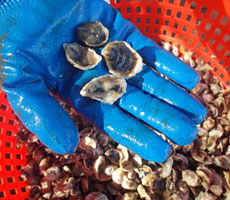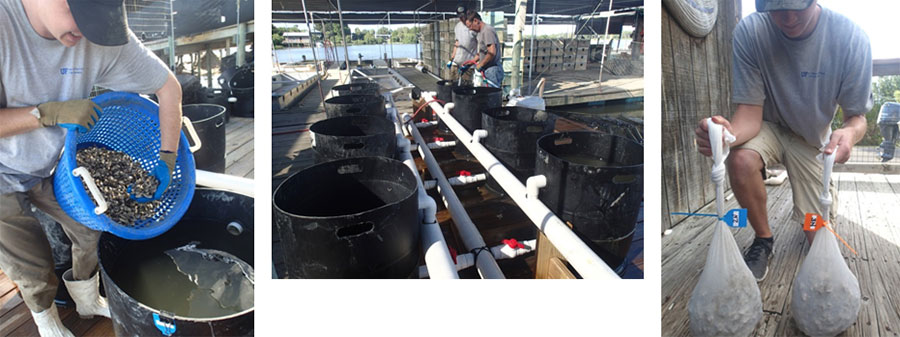Single-set triploid oyster seed were produced in April by crossing Cedar Key stocks with sperm from tetraploid stocks obtained from Louisiana Sea Grant’s oyster hatchery. Diploids were also produced by using the same Florida stocks. Ploidy of larvae and post-set was confirmed. Seed were nursed at a participating commercial facility in their barrel drum system. When they reached about one inch (20-22 mm) in size (shell height), the seed (2500 of each ploidy type) were distributed to participating growers in late July and early August. At this size, most growers were able to stock the juvenile oysters into 9 mm mesh bags. In this project, gear used in triploid oyster culture is identified by using orange-colored tags and tie wraps while blue is used to differentiate diploid oysters.
So what are diploid and triploid oysters?
 Ploidy is the number of sets of chromosomes in a cell. Oysters found in nature normally have two sets of chromosomes and are diploid (2N). During reproduction, the egg and sperm each contribute one set of chromosomes to produce the diploid oyster. In this project, gear used in diploid oyster culture will be identified by using blue-colored tags and tie wraps. Polyploidy is a genetic manipulation (not modification) that can
Ploidy is the number of sets of chromosomes in a cell. Oysters found in nature normally have two sets of chromosomes and are diploid (2N). During reproduction, the egg and sperm each contribute one set of chromosomes to produce the diploid oyster. In this project, gear used in diploid oyster culture will be identified by using blue-colored tags and tie wraps. Polyploidy is a genetic manipulation (not modification) that can
be used on plants and lower animals, like oysters. Polyploids have more than the normal two sets of chromosomes (diploid). If three, they are triploid (3N); if four, they are tetraploid (4N). Many agricultural crops are cultivated as polyploids. In oysters, triploids are produced by crossing tetraploids (as the male) with diploids. Because the tetraploid sperm naturally has two sets of chromosomes when it combines with an egg from a diploid with one set of chromosomes, triploid embryos are produced.
Triploid seed, as it develops, is sterile, and will not reproduce, creating potential production advantages. The value of triploid oysters has been demonstrated in many coastal states. It seems potential exists for triploids throughout the geographic range of the eastern oyster Crassostrea virginica. Yet, site-to-site variability in production benefits of triploidy to oyster aquaculture, as well as gear type-interaction, have been noted by several researchers. Despite the proof of concept in other states, there is a need to fully understand whether the application of triploidy in the development of an emergent oyster culture industry on Florida’s west coast will result in increased oyster growth and survival and therefore beneficial economic gains.




